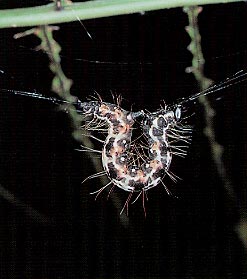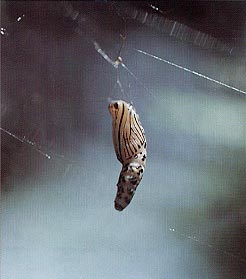|
This family-group
concept is based on the western Palaearctic genus Orthostixis Hübner, a
smaller, more delicate taxon than Naxa, but where the wings are white
with a similar distribution of dark grey spots. The male antennae in Orthostixis
are weakly serrate rather than bipectinate in both sexes, as in Naxa, but
the forewing radial system includes an areole between R1 and Rs based well short
of the angle at the apex of the cell whence M1 branches off. In Naxa the
areole is relatively larger, with R4 and R5 connate at its apex (Bornean
species; Fig 4) rather than arising from it on a long common stalk. The hind
tibia in Orthostixis has one pair of short spurs: these are lacking in Naxa
(Inoue, 1961).

The male genitalia of Orthostixis
have simple valves somewhat as in some Boarmiini. The juxta is elongate,
flask shaped. The uncus is expanded gently towards the apex, finely setose. The
aedeagus is a simple tube with no cornuti in the vesica. There are no setae on
the third sternite. The genitalia in Naxa are similar, but the valves
lack robust setae along the costal margin, the uncus is slender, acute, and the
gnathus, strongly present in Orthostixis is absent.
The signum in female Orthostixis
is ennomine-like, elliptical, with a serrate margin. In Naxa it is
weaker, more irregular.
The larva in Orthostixis
has the setae prominent as in Naxa. A full description of larva and
pupa was published by Rebel (1903: 260). The larva is
stout,
with strong bulges and folds, the setae set on tubercles. The host-plant is Scutellaria
(Labiaceae). The pupa is bone white with a black pattern and yellow spots as
in Naxa.
There are thus a number
of features to suggest a relationship between Naxa and Orthostixis, such
as the facies, areole, general structure of male and female genitalia, strong
larval setation and striking pupal markings, but no really unambiguous
synapomorphy. Neither genus should be placed in the Oenochrominae sensu
stricto.
Biology: Orthostixinae
The mature larva, pupa and host-plant of Naxa guttulata Warren
were observed by the author and colleagues at Poring Hot Springs during
March, 1997 (See Systematic Account). Three pupae retained emerged as adults and the
specimens are in the collection of Universiti Malaysia Sabah. Whilst
congeners have been reared from Oleaceae (Holloway 1996a), guttulata was
found feeding on the fronds of large ferns growing on the forest floor.
Only one species appeared to be utilised, identified (Chew Ping Ting and
J.M. Camus, pers. comm.) as Diplazium ?megistophyllum (Copel.)
Tagawa (Athyriaceae). The appearance of larva and pupa and their
occurrence in a small colony suspended in a web under the arches of the
fronds, is exactly as described for congeners, the pupae suspended head
upwards in the web. Both are illustrated below. Only one web was
occupied but a few others were observed on the same fern species in the
vicinity. An adult disturbed from the undergrowth came to rest on the
underside of one of the fronds of the tenanted fern. Fern-feeding is an
unusual and specialised habit in the Lepidoptera, only known otherwise in
the Geometridae in the ennomine tribe Lithinini.
 |
 |
|
Larva
(left) and pupa (right) of Naxa guttulata Warren in
webbing under the arch of a frond of a Diplazium fern at
Poring Hot Springs (photos by Dr D.J.L. Agassiz). |
>>Forward
<<Return to Contents page
|



